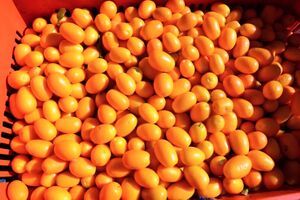Koum kouat Kerkyras Κουμ Κουάτ Κέρκυρας (Corfu kumquat)

PGE/ΠΓΕ Koum kouat Kerkyras Κουμ Κουάτ Κέρκυρας is a typical orange coloured fruit of the Kerkyra (Corfu) Island obtained from the variety Fortunella margarita (kumquat). It is a small tree with abundant foliage and an intense green colour, characterised by white flowering, which has a scent similar to that of citrus fruits.
Production Method
Flowering takes place in the months of March and April and the fruits are collected in the month of May. The collection of the fruits is traditionally done by hand, following a first qualitative selection. Only the fruits that reached full ripeness and do not have defects are collected. The unripe fruits are collected successively. Transportation takes place the same day of the gathering, placing the koum kouat in specific plastic containers. The terrain is fertilised every year and in the case trees present traces of mealybugs, pesticides are used before the flowers appear.
Appearance and Flavour
The PGE/ΠΓΕ has an oval shape, an orange colour and is approximately four centimetres long. Its taste is characteristic and recalls that of citrus fruits. This is the only fruit of the Citrus family that is eaten with the peel, which is very rich in essential oils and vitamin C.
Production Area
The production area of the PGE/ΠΓΕ is exclusively on the island of Corfu, in the Ionian Islands.
History
The history of the PGE/ΠΓΕ is linked to its old and original cultivation in China and Japan. It was brought to Corfu by the English botanist Merlin 1924, who discovered the koum kouat during a Japan visit. Currently, thousands of trees are present throughout the island and its production is by now linked to this territory.
Gastronomy
The PGE/ΠΓΕ Koum kouat Kerkyras should be kept in a cool and dry place. The fruit can be consumed fresh, as fruit compote, in syrup or glazed. For the compote, the selected fruits are rinsed and boiled. Successively, they are cooled off, processed with water and placed in specific glass containers. Finally, diluted syrup is added, the containers are closed and sterilised. For the Koum Kouat in syrup, the ripe fruit are selected and washed with a solution diluted with citric acid. Another rinsing follows with large quantities of water. The fruits processed this way are ready for boiling, until they are soft enough. After that, they are left to cool off and a first dose of syrup (diluted) is added. After five days, the concentration of syrup is increased, until it reaches 74-75°Bx. The Koum Kouat are thus ready to be packaged in glass containers, to which a last dose of thick syrup is added, before they are closed and sterilised. For the glazed koum kouat, the processing is the same as that for the fruits in syrup, but before they are packaged, they are rolled up in the icing (a very dense syrup) and barbecued to make them dry. These glazed Koum Kouat are then rolled up in cling film and packaged.
Marketing
The product is sold as PGE/ΠΓΕ. It is marketed fresh, packaged in paper boxes with holes on the sides, or processed, packaged in glass containers and placed in cardboard boxes of 12 containers for the compote, and various sizes for the versions in syrup and glazed.
Distinctive Features
Corfu is basically the only place in Europe where the koum kouat is cultivated. The PGE/ΠΓΕ grows mainly on the northern part of Corfu, where the mild climate, the fertile ground and the water abundance make it the ideal place to prosper.
Reference: Qualigeo
#fruits #fruit #citrusfruits #clingfilm #oils #citrus #barbecued #kumquat #vitaminc #citricacid